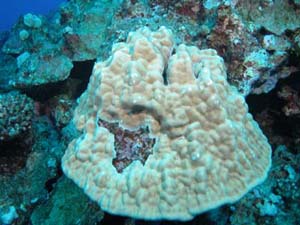13th August - 22nd August, 2004

Barrier reef
24°C
No bleaching observed
There were no visible signs of disease.
20 meters
Several observed on each dive.
Rarotonga is the main island and center of the Cook Islands. It has a population of 10,500 covering about 67.2 square kilometers. Inland consists of tropical forests and well maintained taro gardens. The coastline of Rarotonga is lined with sandy beaches and is surrounded by a shallow lagoon and protective outer reef.
Observations were made on survey dives along the North coast between Avarua and Avatiu Harbor. The reef structure consists of large coral bommies closely packed together along a sandy bottom. There were many genus observed, including Pocillopora, Acropora, Porites, Montipora, Leptoria, Favia, Goniastrea, Acanthastrea, Montastrea, as well as many soft corals. Although there were many genus, the majority of colonies observed were very small (between 5-20 cm in diameter) indicating new growth. There were very few (10 maximum observed per dive) large and healthy Acropora, Pocillopora, and Porites colonies. We observed the reef to be 90-97% dead with the majority of coral colonies covered in sediment, mucous, filamentous, and encrusting algae.
It is easy to see that this was once a very beautiful reef with diverse and very striking coral formations. The coral skeletons have kept their shape but are, for the most part, completely dead.
Hundreds of pink-spined reef urchins (Echinometra viridis) were observed along the reef structure. Each coral bommie could have anywhere from 10-40 small reef urchins within the contours of the coral skeleton. There were also many black, longspined sea urchins (Diadema spp.) along the reef. A few black, spiny sea cucumbers and giant clams were also seen along the reef. We observed several crown of thorns on each dive and even saw them feeding during the daytime. The dive companies informed us that they often see them during dive trips along the Northern Reef. The dive companies are aware of the harm that crown of thorns can have and remove them when possible. Local fishermen also reported of having seen many crown of thorns in the past along the reef.
In the 1960's, Rarontonga was known for their orange plantations. Thousands of oranges were grown using pesticides and then sent to New Zealand. We were told that all oranges exported to New Zealand were first rinsed in large vats of fungicide on the dock at Avaroa Harbor. When the fungicide was unable to be used anymore, the vats were spilled directly into the Harbor and washed over the reef and out to sea. In the late 1980's, Rarotonga stopped its orange production. We were also told that fungicides and herbicides were used in agricultural processes on the island during the 1960's and 1970's including DDT and Melathion, two very toxic pesticides. These chemicals have seaped into the soil. Many islanders have started using hydroponic systems in order to grow produce and flowers. In January of 2004, some Rarotongans began to complain of chest infections and respiratory problems. Certain areas around the island were designated "no swimming" zones for short periods of time until things appeared to clear up. Some people have speculated that the sickness is because of pesticide and herbicide runoff, although no formal investigation has been conducted. Community action groups have been formed to deal with the problem. Environmental services on Rarotonga recently broadcast an advertisement for islanders to keep all pigs and cattle a certain distance away from nearby streams and rivers to avoid fecal contamination.
There was a small amount of recycling of aluminum cans and plastic bottles but also some trash along the roadsides. A lot of trash is burned and many fires were observed on the island daily. On one dive outside Avaroa Harbor, we found plastic bags, aluminum soda cans, and large sheets of plastic covered paper. Sewage is also an issue, as there is currently no universal sewage treatment facility. The tourism authorities now require all new tourist facilities to have tertiary treatment systems before giving them accredidation and after the sickness scare in early 2004, there is talk of more sewage treatment.
No one really seems to know exactly what happened to the Rarotonga reef. All sources agree that the reef used to be alive and beautiful and that it died relatively quickly in the 1960's and 1970's. Contributing factors to its decay have been the use of chemicals in the agricultural processes on the land which have run off onto the reef, sewage runoff and high numbers of crown of thorns. The numbers of crown of thorns appear to be decreasing and there is a significant amount of new coral growth along the reef. There is a good chance that the reef will recover over time.
We would like to thank Nan Hauser and Jo Anderson for their invaluble help and information